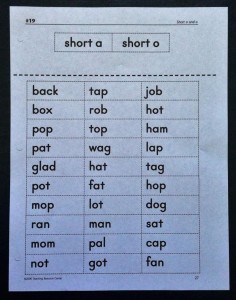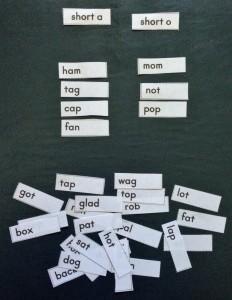by C. Elkins, OK Math and Reading Lady![]()
This is part 2 of a series on ways you can efficiently listen to your students as they read, identify cueing systems the child is using / neglecting, and offer helpful prompts that will guide them as they read. This blog will focus on the Structural Cueing System. Even though this is considered an early reading strategy, there are many intermediate elementary students (and higher) with reading difficulties who would benefit from this type of analysis and prompting.
The second cueing system is the use of (S) Structure or Syntax of our English language. Much of a child’s knowledge about language structures comes as a result of speaking or listening to how language naturally sounds. A reader attempts to make it sound right. Below are 3 possible scenarios with analysis of a child’s possible response.
Using this text: She runs with the puppy.![]()
1. Suppose a student read it this way:
√ ran √ √ √.
She runs with the puppy.
This student is using structure because “She ran . . .” sounds right. He/She is also using M (meaning) because it makes sense. And the child is using visual (V) cues because ran / runs are visually similar.
2. Suppose a student read it this way:
√ runned √ √ √.
She runs with the puppy.
This student is not using structure because “She runned . . .” does not sound structurally / grammatically correct. However, it still makes sense (M) and is still visually similar (V).
3. Suppose a student read it this way:
√ chased – √ √.
She runs with the puppy.
This student is using structure because “She chased the puppy” sounds right. He/She is also using (M) meaning because it makes sense. The child is not using (V) visual cues because chased and runs are not visually similar.
When a child is not using structure, their errors in reading are typically with verb tenses. Often with -ed ending words they will use the wrong pronunciation (such as look-ded), or they will generalize by adding -ed to words which don’t use it to make past tense (runned, swimmed, bited). Or a student may be an English Language Learner – be sensitive to their needs. They may not know what “sounds right.” In that case, you as the teacher should model what it should sound like.
Helpful teacher prompts to help a student monitor for (S) Structure / Grammar:![]()
- Did that sound right?
- Does that sound the way we talk?
- Is there a better way to say it?
- What word would sound right there?
- Can you say it another way?
- Try ______. Would that sound right? Listen as I read it. Now you try.
- Listen to this (give 2 choices). Which sounds better?
Remember, it is often most helpful to wait until the child completes the whole sentence before prompting or trying to correct an error. This gives the child an opportunity to monitor themself and perhaps self-correct. If the teacher (or parent) jumps in right away after the error is made, it is the teacher doing the monitoring, not the student.
To assist you with documentation about the child’s cueing system, see part 1 about Running Records. In your notes for the child’s oral reading, write the word they said above the word from the text. Analyze to see if they are making meaning, structural, or visual errors. Does the child tend to use one cueing system over another? What prompts can you offer to help the child monitor their reading and self-correct?
Finally — be sure to let the student know when you notice their self-corrections and montoring. For example: “I noticed you changed the word ‘runned’ for ‘runs’ in the sentence. You made it sound right! Good for you!” This reinforces use (and hopefully continued repetition) of the strategy.
Happy Listening! Next time Visual Cues – Part 3
Clip art courtesy of MS Office.

 Free phonics lessons:
Free phonics lessons: Here are 12 decoding strategies you might like. These show various ways to help students break apart, analyze, and relate to known words. I only recommend sounding out words letter-by-letter in a few limited situations. Beginning readers do this to apply newly learned letter-sound knowledge. It is a successful method for cvc words and other small words which follow the phonics rules. However, if this is the child’s main method of reading, it begins to become unproductive and impede fluency. In addition to prompting students for meaning or use of structure (see Fix-it Strategies parts 1 and 2), try some of these strategies to help children decode words.
Here are 12 decoding strategies you might like. These show various ways to help students break apart, analyze, and relate to known words. I only recommend sounding out words letter-by-letter in a few limited situations. Beginning readers do this to apply newly learned letter-sound knowledge. It is a successful method for cvc words and other small words which follow the phonics rules. However, if this is the child’s main method of reading, it begins to become unproductive and impede fluency. In addition to prompting students for meaning or use of structure (see Fix-it Strategies parts 1 and 2), try some of these strategies to help children decode words.
 This means if they try one sound and it doesn’t make sense, to try the other sound the vowel makes. This is a quick prompt without the teacher going into a mini-lesson on vowel rules. As a visual reminder, I flip the palm of my hand from one side to the other.
This means if they try one sound and it doesn’t make sense, to try the other sound the vowel makes. This is a quick prompt without the teacher going into a mini-lesson on vowel rules. As a visual reminder, I flip the palm of my hand from one side to the other.



